1973 Ford Pinto Squire: Brougham on a budget?

I can hear it now: “Klockau, we get it, we know you like Broughams, but a Pinto? Come on!” It’s OK, I haven’t gone off my rocker, but some of these first subcompacts from Ford, particularly the Squire wagon and the coupes and hatchbacks with the LDO (or Luxury Decor Option) package, definitely gave off a bit of a Brougham vibe.

But no one’s going to confuse this with an LTD, Marquis, or Continental Mark IV. I mean, it’s a Pinto, for crying out loud. But in 1973, when this baby blue Squire came off the line, Lee Iacocca was essentially running the show despite his name not being on the building, and one thing Lee loved was Brougham.

Yes, Brougham. Chrome, whitewalls, extra side trim, luxury wheel covers, the whole bit. And don’t forget the simulated wood! And, of course, on the Pinto Squire it was inside and out, thanks to the Di-Noc festooned flanks.
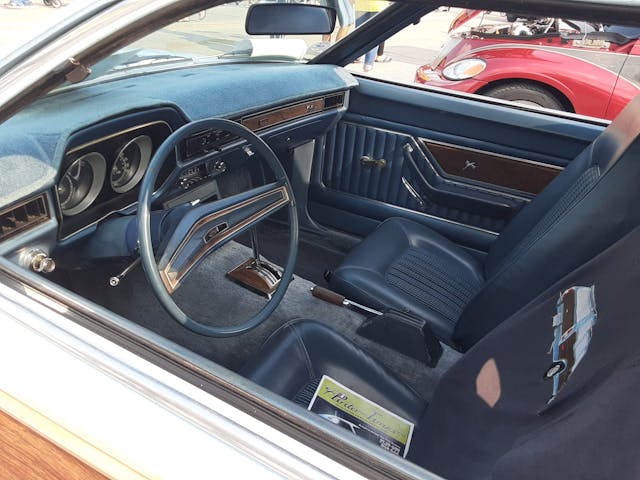
Ask folks of a certain age about the Ford Pinto, and you could either get an earful about a rust-bucket lemon, or about a car that just kept on running for years, or about certain yellow journalism from the ’70s that singled the tiny Ford out for a design that many other contemporary cars also had.

If you were born before 1980 (the last year the Pinto was made, incidentally), odds are someone either had one, knew someone (or several someones) who had one, delivered pizzas in one, went on crazy college road trips in one, and so on.
Once upon a time they were everywhere, thanks to a cheap price and the increasing interest in smaller cars as the 1970s dawned.

Along with archrival Chevrolet, the first Ford subcompact came out for the 1971 model year. Initially offered only as a two-door sedan or two-door hatchback (termed “Runabout” by Ford marketing), it was base priced at $1919 ($13,867 today); a Runabout was $2062 ($14,900).

It sold like dollar beer at a baseball game—288,606 sedans and 63,796 runabouts were delivered for the model year. The runabout/hatchback was not initially available; it debuted several months later at the 1971 Chicago Auto Show.

But the big news for the 1972 Pinto was the addition of a two-door station wagon. It immediately became a healthy seller. Initially offered at $2293 ($16,054), 101,483 were sold for the ’72 model year. That same year, 181,002 sedans and 197,920 runabouts were produced.
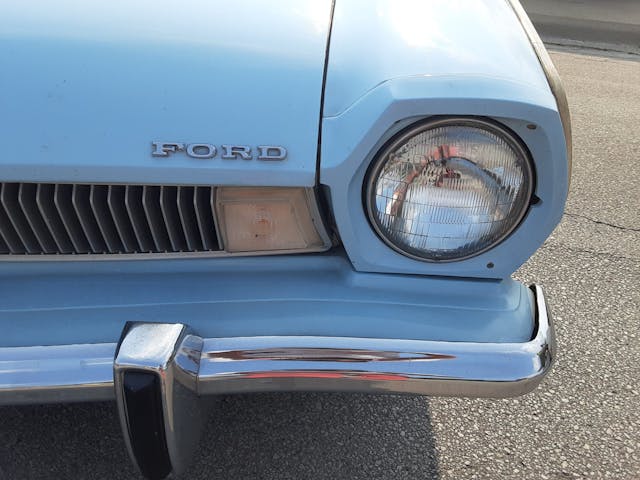
As previously mentioned, from the beginning lots of dress-up and comfort/convenience options were available, but don’t get the idea this could be optioned to mini-LTD specifications. You couldn’t get power windows, power locks, or even wire wheel covers.

But you could get the Cruise-O-Matic automatic transmission, full wheel covers, whitewall tires, a leather wrapped steering wheel, electric rear window defroster, dual color-keyed sport mirrors, metallic “Glow” paint choices, and an AM/FM stereo.

But the real flossy version was the Luxury Decor Option, which was available on all Pintos and included a vinyl insert body-side protection molding, full wheel covers, bright wheel lip moldings, and bright rocker-panel moldings.

But inside was where you really saw the difference, with pleated cloth or vinyl trim, fancier door panels with wood-tone trim, cut-pile carpeting, deluxe steering wheel, wood-tone-accented shift lever and parking brake lever, rear seat ash tray (trust me, this was a big deal in 1973), and more.

But wait! As someone rather famous one said, there’s even more! If you ponied up (pardon the pun) for the Squire option, you got as nice a Pinto as was possible in 1973.
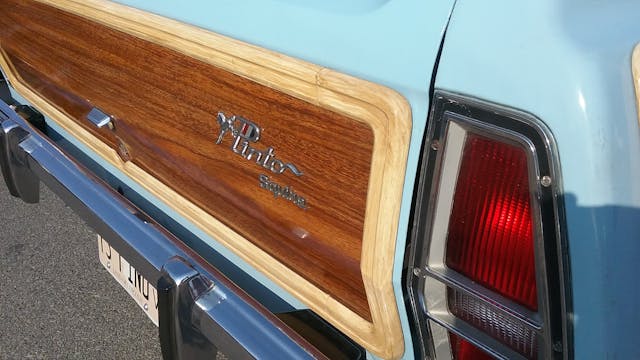
As the 1973 Ford Wagons brochure said (of course I have a copy), the Squire Option was “a beautiful complement to the Pinto Wagon, and a Ford Wagonmaster innovation.” I’m not sure where the innovation was, as in 1973 you could get a Vega Estate across town at your local Chevy dealer. But who knows what the FoMoCo marketeers discussed with their lunchtime martinis?

At any rate, the Squire included all of the Pinto Accent Group and Luxury Decor Group features, plus the woodgrain-clad sides and liftgate. To that, one could also add optional SelectAire air conditioning and tinted glass for an extra plush Pinto.

A 1973 Pinto wagon started at $2319 ($15,285), though naturally the Squire goodies and other options would bump that tally higher. This was the year the Wagon became the most popular Pinto, with an impressive 217,763 sold, along with 150,603 Runabouts and 116,146 sedans. That would dip some in a few years, but as previously mentioned, the car made it all the way to the 1980 model year before being replaced by the front-wheel-drive Escort. And yes, a Squire option was available to the end.
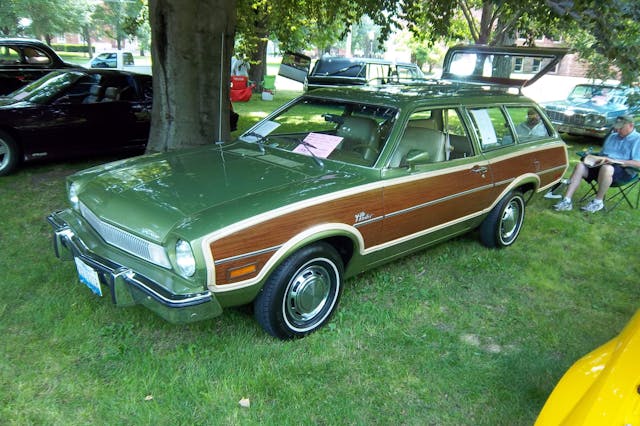
Escorts and Pintos, sigh. They used to be absolutely EVERYWHERE, but you’d be hard-pressed to find one today. The cheap and cheerful price, 1970s-style rustproofing (or rather, the lack thereof), and the fact that most of these cars had the bark beaten off of them means there are few survivors today despite extremely impressive production. I’ve only seen two in person at shows, the Light Blue ’73 featured today and this Clark Griswold-approved green ’74.

I first saw the green one at the 2013 Railroad Days show in Galesburg, Illinois. Back then it was held in Standish Park, near the Knox County Courthouse, and was a great location. Though it’s since moved to Main Street, it is still a great annual event that draws a bunch of interesting cars.

I see both Pintos at several shows a year, including the most recent 2022 show season. They always make me smile. I just like the uncommon stuff, I guess; I’ll walk past a row of red Corvettes and resto-mod Camaros to look at a Cordoba, Granada … or a Pinto!
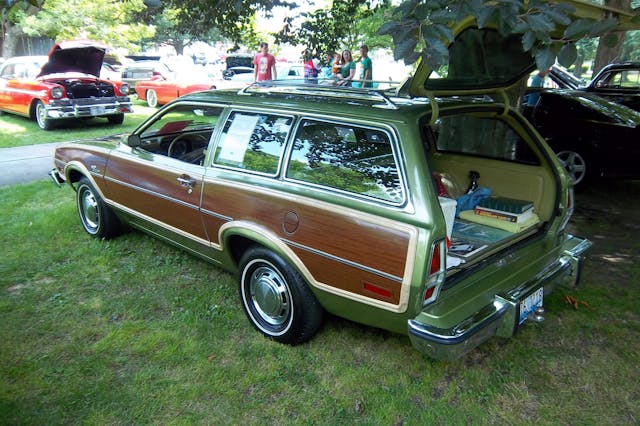
And while I am still atop my soapbox, may I say that if we’re apparently no longer going to be getting many station wagons or sedans from manufacturers anymore, can we at least get some wood sides for our combovers? Please?

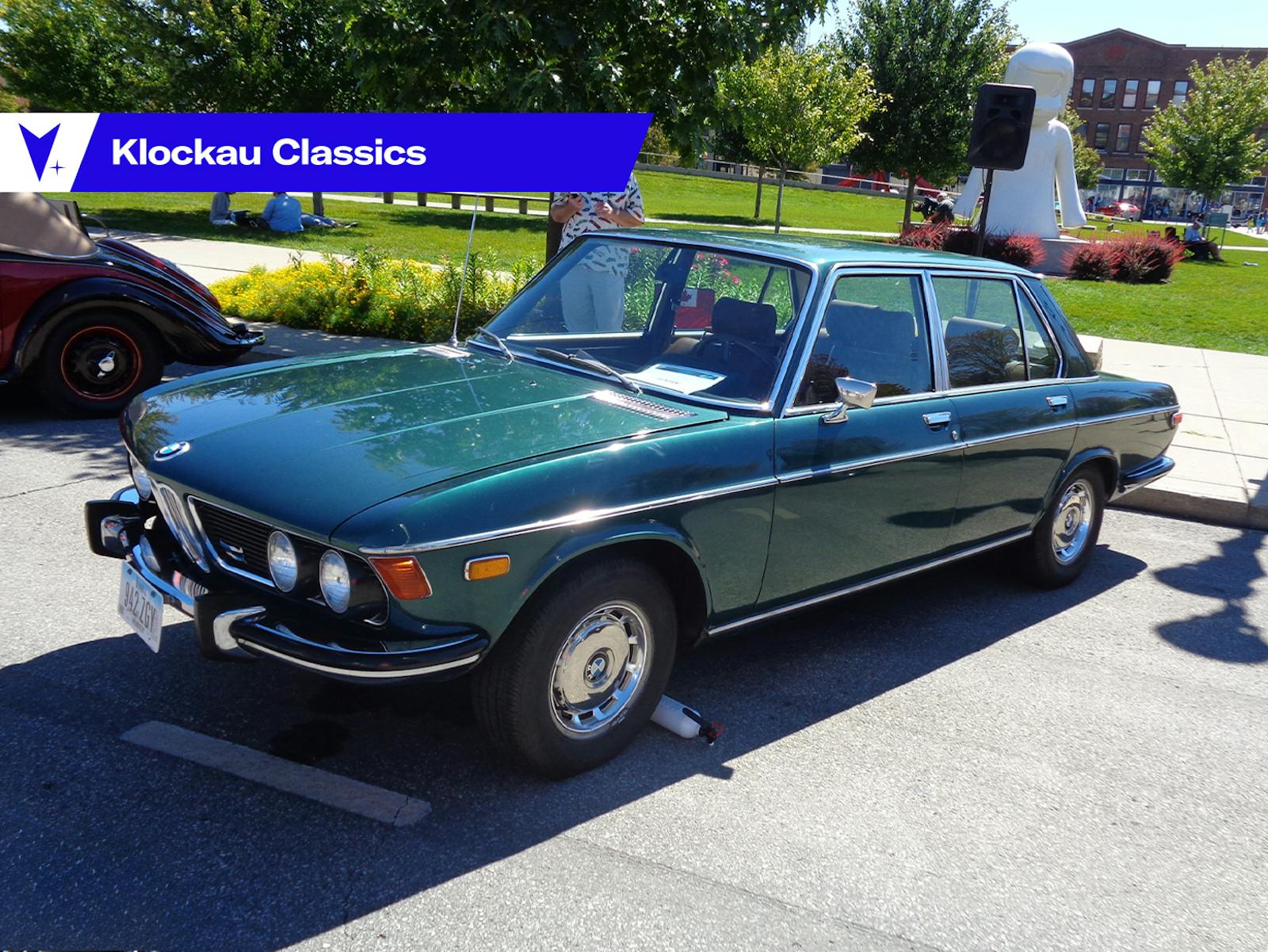

My dad had a ’74 Vega he bought new as I turned driving age. My buddy’s dad had a ’74 Pinto. Both were 4-speeds. The Vega was more enjoyable to drive. The Pinto seemed to be more durable, especially regarding rust. Nothing about either car would tempt me to buy one today. But I have great memories chasing that Pinto, and being chased by it. Still good friends with that guy today. Thanks for a fun article.
Don’t forget about the Mercury Bobcat version. Just as much fun. I drove a 1976 Bobcat all through college until it burned a whole in one of the cylinders on the way home. Made it home with a top speed of 45 mph.
Didn’t have the Squire/wagon versions , my buddy did. Tinted the back windows, threw a pillow and blanket back there and he had a “shagging wagon”. I had a 75 hatchback, 2.3 with the 4 speed and factory steel mag rally wheels. Put an after market header and exhaust, radial T/As and it sounded good and handled pretty good with those low profile 60s radials. Drove it back and forth to college and everywhere in between for 2 years, traded it in on a new Fiesta Sport, but that’s another story..
I too had the clutch cable let go, the little lead knob on the end pulled off, I finished my commute to AND from school by turning it off at every stop light or sign , then restarting it in 1st when it was my turn to go. Pretty much indestructible little car.
I graduated HS in 1973, and one of the cars I would like to have had (being somewhat realistic: I did not envision getting a Porsche 911, or even a Cougar convertible, as I entered college) was a light blue (like the subject car) Pinto wagon. It would have had to be a 2.0 and 4-speed (no sickly 4/automatics combos from that era); anything else would have been nice but not necessary. NO wood sides though; I did have my 18-year-old pride! An alternative would have been a Vega wagon, with the 2.3 and 4-speed.
A friend’s family bought a new 1972 Pinto stripper, with the 1600 and 4-speed. It proved to be quite durable, being pressed into newspaper delivery service without a complaint. Boy, was that 1600 SLOW, though – VW Beetle slow, but without the leap off the line a 1500 or 1600 Beetle had.
In the late 1980’s, I worked with a woman who drove a Pinto woody wagon with the V6 and automatic; she seemed to really like it. Later, she replaced it with an Escort two-door.
Really enjoyed this Pinto wgn.article thanks, how much fun would this car be with the 2.7 twin turbo drivetrain
I was a car washer/oil changer at a small Ford dealership in 1976.
One thing I liked about Pintos, was that the drivers seat fit me well, and the door handle’s position with the armrest felt “natural”.
During that time the 2400 cc engines were failing because Ford neglected to put an oil squirter hole in each connecting rod to lube the cylinders.
My mother had a 72 Pinto Runabout , 4 speed manual , bought from the original owners in 1977, my grandparents. The master cylinder gave out a week later ! Other than that, it never left my mother stranded until it met it’s fate on Christmas Eve 1980 when it slid on an ice patch and ate a telephone pole. Thankfully , my mother and I walked away , uninjured .
Ford Made a special model of the Pinto Wagon with only bubble windows in quarters,with a V-6 and awesome red paint scheme.
Bought a new Mercury Bobcat wagon in 1974 – an upscale version of the Pinto sold in Canada. Traded that one in on a big Ford after 2 years. Went back into a string of Bobcats into the early 1980s. I drove them til they dropped, then went for another. The 2.3 liter 4 was a really solid engine – hard to kill. Nice little runaround wagons, cheap on gas, easy to fix. Unfortunately they got harder to find in decent shape and they were disappearing from the wreckers. Still miss them.
As a side note, nobody mentioned the panel delivery option for the Pinto, as well as the Cruising wagon option. The side windows were covered with a fiberglass panel. The cruising wagon had porthole windows like the big vans.
I had a college friend & bought the first model year ’71. I t had 4 spd. and the 1600 cc German Ford engine. It only had an AM radio. I was surprised at the handling feel of the car! I think it was rack & pinion. He kept that car until came back from the VN war 3 years later. He kept going back and luckily he survived with no issues. He used his GI Bill to become a doctor and to this day he still this trusty old Pinto! Since we live in Texas the car is in good shape. To me this Pinto was America’s answer to the VW Bug but better except for the exploding gas tank!
So fun to go down memory lane My dad had two pinto station wagons. One was bright red of all colors! He loved that he could haul stuff for his FFA students on a teachers salary. Good on gas and fit a piece of plywood. That black vinyl would take the skin off your legs on a hot day. As a kid I couldn’t understand. As an adult I get it.
I had 4 pintos, 3 two doors & a green wagon, The last 2 door I put a 302 in and converted it to a 2 seater with a killer stereo in the back and battery in the trunk. It was a great sleeper, surprised a lot of people, looked stock except for luvered hood. Should have keep it.